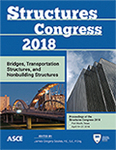Structures Congress 2018
Minimizing Ends’ Cracks of Skewed Pre-Tensioned Box Beam Concrete Girders
Publication: Structures Congress 2018: Bridges, Transportation Structures, and Nonbuilding Structures
ABSTRACT
Precast pre-stressed box beam bridges are extensively used in short and medium span bridge design throughout the United States. Recently, skewed geometry and heavy pre-stressed box beams were developed. Field inspection of such beams indicated most of them experience vertical and inclined cracks within end regions of the box beam. The range of crack widths was within the limit that is required to be repaired before being used in the bridge construction. The depth of cracks was found to be very close to the tie rods and beam’s reinforcement. Field observation also indicated that cracks were more intensive at the acute corner than the obtuse corner. The beams with cracks form a durability concern, especially when the water and chemical agents filtrate through the cracks and reach the tie rods and strands. Therefore, a three-dimensional nonlinear finite element model was developed to simulate the behavior of the box girders after releasing strands. Case study girders surveyed during site visits were used for modeling and validating finite elements. The beams were modeled with actual material properties, geometry, and strands cutting sequence. The finite element results were validated with measured data in terms of crack locations and upward deflection. Two of the most appropriate crack-controlling techniques found in the literature were evaluated with finite element analysis: modification of beam design and debonding strands. The results of this study showed the modified girder design technique significantly minimize cracks at the top of the end zones if two strands with full pre-stressing forces were added around the vertical centerline of the top flange. A 35% level of strands’ debonding technique appeared to be effective in minimizing the maximum tensile strain at the beam’s ends. Debonding exterior strands was more effective on reducing tensile strain than debonding interior strands. The box beam with two strands at the top flange is recommended for implementation by skewed box beam design.
Get full access to this article
View all available purchase options and get full access to this chapter.
REFERENCES
AASHTO, L. Bridge Design Specifications 2012 Washington, DC, USA American Association of State Highway and Transportation Officials.
ABAQUS 6.14-2 [Computer software]. Dassault Systèmes Simulia, Providence, RI.
Adjacent box beam changing the design of the bridge. https://www.pci.org/PCI/Resources/Transportation_Engineering_Resources/Adjacent_Bridge_Beams/PCI/Design_Resources/Transportation_Engineering_Resources/Adjacent_Bridge_Beams.aspx?hkey=00b6bebe-7a80-413b-ad7a-0686af3408c9, accessed on Oct. 5. 2007 at 10 pm.
Kannel, J., French, C., & Stolarski, H. (1997). Release methodology of strands to reduce end cracking in pretensioned concrete girders. PCI Journal, 42(1), 42–54.
Marshall, W.T., and Mattock, A.H., “Control of Horizontal Cracking in the Ends of Pretensioned Prestressed Concrete Girders,” PCI Journal, V. 7, No. 5, October 1962, pp. 56–74.
Mutashar, R., Sargand, S., & Khoury, I. (2017). End Zone Cracks for Skewed Pre-Tensioned Box Beam Concrete Girders. In Congress on Technical Advancement 2017 (pp. 77–88).
Okumus, P., & Oliva, M. G. (2013). Evaluation of crack control methods for end zone cracking in prestressed concrete bridge girders. PCI journal, 58(2).
Okumus, P., & Oliva, M. G. (2014). Strand debonding for pretensioned bridge girders to control end cracks. ACI Structural Journal, 111(1), 201.
Tadros, M. K., Badie, S. S., & Tuan, C. Y. (2010). Evaluation and repair procedures for precast/prestressed concrete girders with longitudinal cracking in the web. Transportation Research Board, Vol. 654.
Tuan, C.Y., Yehia, S.A., Jongpitaksseel, N., Tadros, M.K., “End Zone Reinforcement for Pretensioned Concrete Girders,” PCI Journal, Vol. 49, No. 3, May-June 2004, pp. 68–82.
Information & Authors
Information
Published In
Structures Congress 2018: Bridges, Transportation Structures, and Nonbuilding Structures
Pages: 133 - 144
Editor: James Gregory Soules, CB&I
ISBN (Online): 978-0-7844-8133-2
Copyright
© 2018 American Society of Civil Engineers.
History
Published online: Apr 17, 2018
Published in print: Apr 17, 2018
Authors
Metrics & Citations
Metrics
Citations
Download citation
If you have the appropriate software installed, you can download article citation data to the citation manager of your choice. Simply select your manager software from the list below and click Download.
